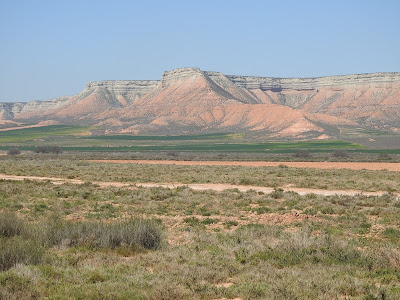Northern Spain. Mid-March. The end of winter. I visit my friend Tad at his house near Figueres in Catalonia. We took a trip to 'Parc Natural dels Aiguamolls de l'Empordà', close by on the coast - an area of wetlands miraculously saved from the intensive urban development which was planned to cross the river from the north.
Always a pleasure to see Garganey with their characteristic white crescent over the eyes. They come from Africa in the Spring to spend summer mainly in Eastern Europe - but a few stay in Spain.
The closely-related Teal is resident here - it sports a broad iridescent blue-green head band.
We followed a Sparrowhawk into a tree, to see it was really a kestrel.
Then off on the 400km journey west to Zaragoza in Aragon. Before leaving Catalonia I pass by Lleida, a famous fruit production area which I used to visit for work. It is blossom time.
South-west of Zaragoza is an area of dry steppe - home to a number of specialist birds
I have come to see Larks. There are four resident species: DuPont's Lark (
Chersophilus duponti) and Lesser Short-toed Lark (
Calandrella rufescens), both only found in such habitats in Spain and North Africa; Calandra Lark (
Malanocorypha calandra); and Thekla Lark (
Galerida theklae).
Walking the steppe at dawn I saw, for the first time in my life, a DuPont's Lark - not easy to see, but it scurried and sat just as shown in the Collin's Bird Guide.
Next, Lesser Short-toed Lark. Similar to Skylark and Short-toed Lark - especially in worn Spring plumage - but identified by its really stubby beak, pale streaked breast, and fewer and larger spots on its sides (coverts).
Thekla Lark is very similar to Crested Lark, and both occur together in Spain.
I believe this to be Thekla Lark: the convex mandibles - giving a stubby appearance to the bill, rather than long and hooked; distinct streaking on the breast; and the pale 'spectacles'.
There are five sub-species of Thekla Lark recognized in North Africa - I assume divergence has taken place among 'island' habitats surrounded by desert.
I saw Calandra Larks flying around, identified by the blackish under wings - big, sturdy Larks.
I stayed in the village of 'new' Belchite. Next door is 'old' Belchite - left in ruins after destruction during the Spanish Civil War in 1937.
The Griffon Vultures circling overhead added to the deathly feel of the place.
Driving around the area I saw other steppe specialists. Stone Curlew...
...and Black-bellied Sandgrouse.
Short-toed Eagles were out looking for snakes.
Even a common Black Redstart photographed well.
Looking down instead of up showed a mating pair of Egyptian Grasshoppers (
Anacridium aegyptium), with the characteristic stripes on their eyes.
On a hill I found a bee orchid,
Ophrys fusca (or close relative). Bee orchids look and smell like female bees. Male bees try to mate with them, and in doing so pollinate them. It's called 'pseudocopulation'. There are around 130 species of bee orchids in Europe, each attracting different bee species. This 'coevolution' was described by Darwin in his 1862 book 'Fertilization of Orchids'. O. fusca attracts
Andrena bees.
Last stop before Barcelona airport: Parc Natural del Delta de l'Ebre - about 150km south.
Sunset spent looking over the reeds at Poble Nou.
Glossy Ibis emerged into the open to feed - reflecting the evening light on their gloss.
Marsh Harriers quartered for one last meal.
A resident Common Chiffchaff (
Phylloscopus collybita) hopped in the reeds. Soon he will be joined by his migrating cousins coming back from wintering in Africa. Next week it is Spring.
And for my last night dinner, the best Razor Shells I have ever eaten.





































